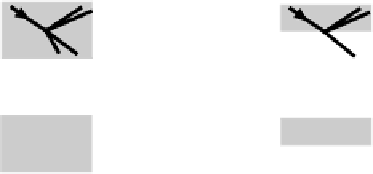Geoscience Reference
In-Depth Information
reduced time-distance plot; phases with velocity less than
v
have a positive slope
and phases with velocity greater than
v
have a negative slope. Reduced record
sections greatly facilitate correlation of phases. Refraction data are generally
plotted with a reduction velocity appropriate for the first-arrival velocities: long-
range crustal/upper-mantle refraction lines would require a reduction velocity of
perhaps 6.6 or 8 km s
−
1
,whereas a record section wth first arrivals from the deep
mantle would need to be plotted with a reduction velocity of
14 km s
−
1
.
∼
4.3.5 Amplitudes
Reflection
and
refraction coefficients
Although we can determine a velocity-
depth structure by using only the first-arrival travel times and the offset distances,
much more information clearly is available from seismograms. Using amplitude
information and the travel times of secondary phases can help immensely to
minimize errors and to reduce the number of possible structures that could fit
the first-arrival time-distance data. The examples of Fig. 4.35 showed common
situations for which the first-arrival times do not tell the whole story.
To be able to use the information in the amplitudes and waveforms of seismic
waves, it is necessary as a start to determine the amplitudes of reflected and
refracted waves at interfaces. Figure 4.37 shows the rays reflected and transmitted
at an interface between two media. Consider first the case of an incident P-wave,
which gives rise to reflected and transmitted P-waves. This incident P-wave can
also generate S-waves when it strikes the interface. Since the particle motion
for P-waves is longitudinal, there is no motion in the direction perpendicular to
the plane of the page, i.e., into or out of the page. This means that the S-waves
generated by the incident P-wave cannot be SH-waves and must be SV-waves.
Similarly, an incident SV-wave can generate reflected and refracted SV- and P-
waves, but, in the case of an incident SH-wave, only SH-waves can be transmitted
and reflected.
Figure 4.37.
Reflection
and transmission
(refraction) of P-waves,
vertically polarized shear
waves (SV) and
horizontally polarized
shear waves (SH) incident
from above on the
boundary between two
media (solid, shaded;
liquid, white). Remember
that S-waves cannot
propagate in a liquid.
Notice that incident
P-waves can give rise only
to reflected and
transmitted P- and SV-
waves and that incident
SH-waves can give rise
only to reflected and
transmitted SH-waves.
(After B ath (1979).)
SH
SH
SH
SH
Incident SH
SH
SV
SV
P
SV
SV
P
Incident SV
P
SV
P
P
SV
P
SV
SV
P
P
P
P
P
Incident P
P
P
SV
P
SV
P























